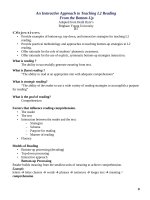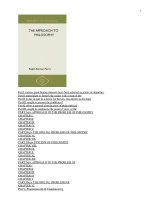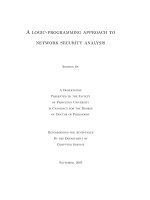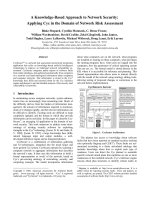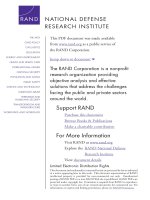State managed marketization chinas approach to oil security
Bạn đang xem bản rút gọn của tài liệu. Xem và tải ngay bản đầy đủ của tài liệu tại đây (1.39 MB, 277 trang )
CHAPTER 1 STATE-MANAGED MARKETIZATION APPROACH – A
THEORETICAL FRAMEWORK
Ⅰ. Introduction
How has China’s approach to oil and gas security been shaped?
1
This is the
central question that this study aims to examine. With the economic boom and
concurrently surging oil and gas demand, China has become increasingly dependent
on foreign imports. Such a growing reliance has aroused the government’s deep
concern about oil security, and a series of measures have thus been taken to tackle
it. Due to the profound impact of China’s dependence on the global market,
2
along
with the far-reaching influence of a rising China on the world, its approach to oil
security has attracted wide attention: What view does China take on energy
security? How has China coped with it? What are the implications of China’s
approach?
The question becomes trickier when it comes to the Janus-face character of
China. On the one hand, further push for the establishment of market economy and
WTO obligation fulfillment call for more market openness in its oil sector. On the
other hand, despite great leaps in economic transformation, the regime remains an
authoritarian party state which tries to rule out any change that may jeopardize
regime survival. Hence, maintaining socioeconomic security and stability has been
1
Hereafter, oil security refers to oil and gas security. The concept of oil security and more broadly energy
security will be discussed in the next chapter. Hereafter ‘oil security’ includes gas.
2
As the world second largest oil consumer next to the U.S., it is said that “Chinese oil demand is a key factor in
world oil market” (EIA, “China Country Analysis Brief,” U.S. Department of Energy, 2 August 2005, available
at:
1
a priority for the Chinese Communist Party (CCP) government.
3
Also, the prospect
that conflict in the Taiwan Strait cannot be ruled out. Moreover, given that domestic
oil companies can hardly compete with the multinational oil companies (MOCs),
any further opening of the oil sector might be a time bomb for China's oil security.
4
When combining the two sides, we can find that the government seems to be
walking a tightrope: it has to balance further openness and energy security. This
raises a question: to what extent is the Chinese government willing to open its oil
market? What are the deciding factors? And what constraint is it confronting?
According to international political economy, there are two basic modes
(market and/or state) running the economy and allocating resources for each nation
state.
5
Accordingly, the ways countries adopt to deal with energy security can be
classified as market-dominated approach (MDA) and state-controlled approach
(SCA). MDA is defined as “one which relies to a significant degree on the use of
flexible economic, fiscal and regulatory instruments which seeks to achieve stated
policy objectives through market signals rather than on the use of the rigid
regulations or ‘command-and-control’ type measures which mandate market
outcomes.”
6
SCA denotes greater government involvement in the energy sector
characterized by a panoply of measures such as “setting detailed, quantitative
3
In this thesis, China, CCP government, Beijing, the Chinese leadership, and the state all refer to the Chinese
government in view that the CCP system has controlled the whole China.
4
The MOCs are both profit maximizers and risk evaders. They shoulder no responsibility for China's energy
security. In time of crisis, they may even take advantage of emergencies or just withdraw their investment.
5
Relations between state and market are the central theme of political economy. Gilpin has defined political
economy as “the field of study that analyzes the problems and questions arising from the parallel existence and
dynamic interaction of ‘state’ and ‘market’ in the modern world.” See Robert Gilpin, The political economy of
international relations,
Princeton, N.J.: Princeton University Press, 1987, p. 8.
6
International Energy Agency (IEA), The Role of IEA Governments in Energy: 1996 Update
,
Paris: IEA,
Organization for Economic Co-operation and Development, 1996, p.21.
2
targets for the energy sector, subsidies and other financial incentives including
support for mega projects, price controls, government deals for the purchase of oil
and other barriers to free trade.”
7
Distinctions between MDA and SCA are reflected in the following aspects:
• Price determination within a country. SCA posits it is up to the state to
decide or adjust oil prices, whereas MDA holds that the market plays a
dominant role to dictate prices though sometimes the state may intervene
in the market. But when intervening, the state mainly relies on the
economic means, such as controlling aggregate supply, or adjusting tax
rates.
• Instruments with which the government regulates oil and gas trade. The
SCA manipulates oil and gas trade through administrative instruments,
including license, quota, import ban, high tariff, setting detailed,
quantitative target for the energy sector, subsidy, support for mega project,
government deal and other barriers to free trade, and so forth. The MDA
posits that state intervention for purpose of enhancing energy security is
quite expensive. If the state is involved in the energy market, it should aim
to promote market efficiency and free trade by reference to economic
instruments like tax rate, tariff, interest rate, exchange rate, and budget.
• Oil and gas industry ownership predominance. The SCA deems the
predominance of state ownership as a necessity to safeguard energy
security while the MDA tends to encourage multiple market actors and
competition.
• Degree of openness to foreign investment in the oil and gas sector. Under
the MDA, foreign investors enjoy equal rights with domestic actors to
access the market, and ideally, it is up to the market to decide who wins,
who loses, and thus who will enter or exit. By contrast, SCA sets an array
7
IEA, 1996, ibid., p. 14.
3
of conditions and only those that can meet these conditions and acquire the
grants from the government can embark on business in that market. After
entry, they may still confront various hurdles to run their business.
• Whether energy is source of cooperation or conflict? The MDA regards
energy trade as a source of cooperation while the SCA views it as a source
of conflict and a zero-sum game. The MDA thinks energy trade can
contribute to mutual communication and trust, thus fostering cooperation
among nations. Also, the MDA deems it necessary to establish regional
cooperation as it can promote market efficiency and save costs by way of
avoiding repeated projects. However, the SCA regards energy trade as a
source of conflict. First, because energy is a rare commodity and may run
out soon, what one nation obtains is the other’s loss, that is, a zero-sum
game. Second, for oil-rich countries, to safeguard the safety of their
resources, and for oil importing countries, to ensure the continuous supply
of oil, it is necessary to augment their military power. This competition
becomes more intense between those neighboring countries with territorial
or religious disputes.
• Concerns about the gains from inter-state energy cooperation. When each
can benefit from mutual cooperation, the MDA shows indifference to the
gains the other side would obtain since it recognizes that inter-state
cooperation is a positive-sum game and it is unlikely that both states can
gain equally. However, the SCA’s concern is not “Will both of us gain?”
but “Who will gain more?” If an expected gain is smaller than that the
other state can obtain, it would not embark on such cooperation in that
“one state may use its disproportionate gain to implement a policy intended
to damage or destroy the other.”
8
It seems hardly to verify or falsify
whether a state concerns about relative gain more or absolute gain more,
but Powell may be right. According to him, “concerns about relative gains
8
Kenneth N. Watz, Theory of International Politics. Reading, Mass.: Addison –Wesley, 1979, p. 105.
4
will inhibit cooperation when the utility of military force is high but not
when the utility of force is low.
9
And
• Primary principle of deciding inter-state energy project cooperation. Both
approaches would consider all-round benefits and risks, and would engage
in those projects with high political and economic benefits but few political
risks. Nonetheless, when facing a project which is economically infeasible
but may engender high political benefits, MDA would withdraw in
deference to the principle of profit maximizing. SCA would proceed due to
the alluring political benefits. Table 1-1 shows the distinctions between
MDA and SCA.
10
In spite of the fact that all nations pursue both strategies
to some extent,
11
each state is located differently on the spectrum.
Table 1-1: Distinctions between MDA and SCA
State-Controlled Approach
Market-Dominated
Approach
price determining in one
country’s domestic
market
government dictates, or price
controls
market decides
oil & gas industry
ownership predominance
public ownership predominance
private ownership
predominance
degree of openness to
foreign investment
foreign investors are under strict
control
foreign investors enjoy equal
rights with natives
instruments regulating
trade of oil & gas
import license, quota, import
ban, high tariff, setting detailed,
quantitative target for the energy
sector, subsidy, support for mega
project, government oil deal and
other barriers to free trade
use of economic and fiscal
instruments like tax rate,
tariffs, interest rate, exchange
rate, budget etc.
whether energy a source
of cooperation or conflict
source of cooperation among
nations
source of conflict and
zero-sum game
concerns about gains
from cooperation
absolute gain relative gain
principle to decide to
cooperate between states
strategic benefits prioritize
commercial viability
whether it is commercially
viable
9
David A. Baldwin, Neorealism and Neoliberalism: The Contemporary Debate, New York: Columbia
University Press, 1993, p. 6.
10
In Speed’s (2004, p. 155) vein, liberalization is composed of four main reforms in its fullest sense, that is,
changes of structure of the energy industry, ownership of the energy companies, the structure and function of
government, and the development of energy market.
11
IEA, 1996, ibid., p. 11.
5
What are the Chinese characteristics concerning the approach to energy
security? Some contend that China takes a strategic approach (or SCA),
12
whereas
their opponents claim that China follows MDA.
13
It is hard to conclude which view
is correct, as both can find evidence to support their arguments. Yet just like a group
of blind men touching an elephant, their accounts are partial.
It is true that the Chinese oil sector has long been under state control, but
simultaneously deregulation has been under way.
14
Thus far, more and more market
ingredients have been ushered in, particularly into the refinery and distribution
chains. In light of the above criteria, the Chinese government turns to both MDA
and SCA instruments in most energy policies.
15
Tracing Chinese oil policy reform,
it is easy to find that the reform presents the attribute of “one step forward, two
steps back”.
16
As Downs argues, the strife between MDA and SCA features Chinese
energy security rhetoric and practice.
17
Both the state and the market are brought
into play, and a mix of both state regulation and market operations coexists in the
Chinese oil sector. This thesis argues that China’s way of dealing with oil security is
“state-managed marketization approach,” (SMMA) defined as a process wherein
12
See Philip Andrews-Speed, Xuanli Liao and Roland Dannreuther, The Strategic Implications of China's
Energy Needs,
London: International Institute for Strategic Studies, 2002.
13
See Robert A Manning, The Asian Energy Factor: Myths and Dilemma of Energy Security, and the Pacific
Future. New York: Palgrave, 2000.
14
Deregulation is the process in which a government removes business barriers for purpose of enhancing
market efficiency. Its rationale is that “fewer regulations will lead to a raised level of competitiveness, therefore
higher productivity, more efficiency and lower prices overall.” Wikipedia,
15
For instance, crude oil price has been integrated with global market, but refined oil price is under government
control; NOCs can be allowed to float in foreign exchange markets; Despite some policy constraints, foreign
investors have been better treated than Chinese private firms; Both economic and administrative instruments
including trade bans have been employed to regulate oil and gas trade; and the Chinese government has
engaged in both energy cooperative projects and competitions for oil and gas acquisitions.
16
Robert A Manning, 2000, ibid., p. 84.
17
Erica S. Downs, China’s Energy Security, PhD dissertation, Princeton University, Publication Number: AAT
3110228, 2004, p. 4.
6
the state has to recourse to a set of mixed means to divert the oil sector from state
control to market operation, but in this process it is up to the state to adjust the
extent and scope of market activities.
China’s approach is typical of transitional economies embracing gradualism in
the sense that market mechanisms are allowed into the oil sector not in an abruptly
big-bang way but in a step-by-step manner. In general, the Chinese state intervenes
in a select few ‘strategic industries’ with crucial fiscal or developmental
contributions; more specifically, state intervention focuses more on certain ‘core’
segments with overall controlling or influential capacities within those selected
industries,
18
while other ‘periphery’ zones have gradually been left to the market.
Apparently the transformation process is not without turns and twists, implying that
some ex ante marketized zones might be called off and returned to state control.
This is mainly because in its effort to drive the oil sector towards the end of
marketization, China also bears socioeconomic security in mind. To a great
measure, marketization in this regard is just a means to attain the goal of a higher
degree of oil security. As such, the quality of state “management” is ostensibly
associated with state capacity. However, a strong state
19
is not a sufficient condition
for good performance in “managing marketization” in that the latter correlates with
other factors such as the uncontrollable nature of the market, bounded rationality,
20
18
In terms of the oil industry, state ownership dominance, the upstream business, pricing power, management
personnel, taxing power etc. are such ‘core’ zones.
19
According to Weiss, a strong state possesses three core capacities: “the ability to formulate policy goals and
evolve strategies for implementing them independent of societal pressures; the ability to alter the behavior of
important domestic groups in order to further its policies; and the ability to restructure the domestic
environment (e.g. property rights and industrial structure) in pursuit of its goals.” Linda Weiss, The Myth of the
Powerless State, Ithaca, New York: Cornell University Press, 1998, p. 26.
20
Simon proposed the notion in 1957 in countering against the rational analysis made by Anderson. “Bounded
7
and power abuse. Moreover, it is true that the government endeavors to reduce oil
dependency, but it remains a question mark whether China is a strong state in every
respect regarding oil security. On and off the government encounters considerable
resistance in pushing its policies downwards as will be discussed below.
China’s SMMA can be regarded as a portfolio, comprising the SCA, mixed
approach, and MDA, which are the three values of the dependent variable. The
mixed approach denotes that state and market compete with each other to govern
the oil and gas sector. Differing from the mixed approach, the SMMA is a collection
of state-market interactive dynamisms, whereas the mixed approach is in a
competing situation or a kind of equilibrium wherein state control exists within
some areas of the oil sector while market forces work in the other. Also, the SMMA
differs both from the SCA, where every business is under stringent state control,
and from the MDA, where the market plays a deciding role in running the oil sector.
With the SMMA, the state intervenes in the oil market for purpose of social
stability, economic security and state asset increment, rather than merely for market
efficiency. Theoretically, we may indicate their differences as shown in Chart 1-1.
Chart 1-1: Approaches to Energy Security
SCA mixed approach MDA
State-managed marketization approach
rationality” means that an agent’s behavior is “intendedly rational, but only limitedly so.” Rationality basically
means to purse an optimal goal with the resources available. See J. Anderson, “Cognitive Architectures in a
rational analysis,” in K. VanLehn (ed.), Architectures for Intelligence, N.J.: Hillsdale, Lawrence Erlbaum
Associates, 1991, pp. 1-24; H.A. Simon, Administrative Behavior: a study of decision-making process in
administrative organization, New York , Macmillan, 2
nd
ed., 1957, p. xxiv.
8
China’s approach reflects gradualism, the overall guiding principle of Chinese
reform epitomized by “groping for stones to cross a river” (mozhe shitou guohe). It
is true that reform and opening-up in the Chinese oil industry complies with this
principle, but should we go no further, we might lose sight of the strategic thinking
of the Chinese government, the opportunities and constraints it has confronted and
the ongoing competitions in the Chinese oil market. Neither can we understand why
deregulations or re-regulations came about at certain junctures, nor can we tell the
future direction of China’s approach.
This dissertation intends to study how and why China employs state-managed
marketization approach to cope with oil security, and what its implications are. I
argue that China’s approach to oil security has largely been decided by the interplay
between the government and the national oil corporations (NOCs), the pivotal
policy maker and the overriding policy enforcer respectively. Specifically, a MDA
or a SCA will be employed respectively when one side’s role can be expected and
accepted by the other; but if they have different role expectations, a state-market
mixed approach will be the policy option.
The SMMA that China has taken provides readers a new perspective to
understand the state-market relationship in the globalizational world. While Lu
suggests that state engagement to promote marketization is a must in China, Lin
verifies that state capacity building goes hand in hand with marketization.
21
I
21
Feng Lu, State, Market, and Enterprises: The Transformation of Chinese State Industry, Doctoral
dissertation, Columbia University, 1999, UMI No.: 9916899; Kun-Chin Lin, Corporatizing China: Reinventing
State Control for the Market, PhD dissertation, University of California, Berkeley, Fall 2003.
9
suggest that market deregulation and state regulation coexist and mutually shift
within the two opposite transitional phases (decentralization before 1998 and
recentralization since 1998) in the Chinese oil industry identified by Lin. State
capacity is important for initiating reform, but with marketization going on, it is not
necessarily compatible with marketization. Thus far state capacity has been
undermined not only by local governments, but also by the NOCs as well.
Second, I explain China’s energy security issue from a new perspective of the
government-NOC interplay.
Though the Chinese NOCs are nominally subordinate
and separate from the government, they “have considerable power and influence
based on their importance to the national economy, their near-monopoly status
despite the 1998 reform, and their previous status as government departments or
ministries.”
22
Philip Andrews-Speed simply portrays the role of NOCs in China
without probing into their interaction with other players.
23
Based on the 1998
overhaul, Lin finds that the core subsidies stood together with the state whereas the
noncore parts reacted against the state's further reform due to the state’s distinct
policies towards them. Based on his findings, I further argue that the NOCs have
both pro- and anti-liberalization propensities, and even the core subsidies do not
merely take orders from the state, while the state is not so strong as to escape
bargaining from the NOCs. Moreover, besides the coercion underpinning Lin's
“strong state” logic and bargaining relationship that previous studies have identified
24
22
Philip Andrews-Speed, et al., “The ongoing reforms to China's government and state sector: the case of the
energy sector,” Journal of Contemporary China, Vol. 23, No. 9, 2000.
23
Philip Andrews-Speed, Xuanli Liao and Roland Dannreuther, 2002, ibid.
24
Kun-Chin Lin, 2003, ibid.
10
(though for the whole state-owned enterprises <SOEs>), I argue the relationship
between the state and the NOCs more often resides in reciprocity.
Third, relationship between the state and the SOEs has long arrested attention
in the academia, but I take a new way to comprehend the state-NOC interplay by
reference to role theory. Since the roles that the state and the NOCs have taken are
influenced by the whole social structure, I construe their roles from an institutional
angle. In the meantime, I am inclined to regard economic reform as a role
transformation process. In order to improve China’s energy security, I stress the
importance of role compatibility and of transparent role expectancy for each other.
Ⅱ. China’s Approach to Oil Security – Literature Review
Other than institutionalism, studies on China's approach to energy security have
three levels: state-, firm-, and system-level analyses.
A. State-Level Analysis
The state-level analysis has dominated the study of China's approach to energy
security. It stresses that the state is the power center which is active and powerful
enough in penetrating into the society despite some bifurcations: whether the state
is a unity with one consolidated national interest (statism) or an entity composed by
different parts, each of which holds disaggregated interests (elite theory and
bureaucratic politics). Difference also exists with regard to which institution is
closest to the power hub.
11
Statists hold that the state (represented by state institutions and political elites)
per se not only has its own interest distinctive from various social interests, but also
enjoys certain autonomy.
25
While sublimating its own interest as national interest,
the state makes every effort to fulfill it. Thus, state capacity, defined as the state's
ability “to penetrate society, regulate social relationships, extract resources, and
appropriate or use resources in determined ways,”
26
has become the catchword in
statist literature. But later statist accounts acknowledge that the state can hardly
distance itself from the society where it is embedded.
27
In the energy arena, the
state also plays a dominant role in preserving and promoting energy security within
one country. State intervention in enhancing energy security is not an issue of
necessity, but a must in the intensely competitive global milieu.
From the viewpoint of China, three distinct views on its approach to oil
security have been developed. Manning claims that China used a market approach
on the ground that China was actively relying on international energy trade,
cooperating with others to tap the remote resources and enjoying the public goods
of sea lane security provided by the U.S.
28
By contrast, Speed et al argue that China
adopted a more “strategic” approach to energy security in that Beijing seemed to
have paid more attention to the political gains from certain projects regardless of
25
According to Krasner, this approach is based on the assumption that “it is useful to conceive of a state as a set
of roles and institutions having peculiar drives, compulsions and aims of their own that are separate and distinct
from the interests of any particular societal group.” See Stephen D. Krasner, Defending the National Interest:
Raw Materials Investments and U.S. Foreign Policy, Princeton: Princeton University Press, 1978.
26
Joel S. Migdal, Strong Society and Weak State: State-Society Relations and State Capabilities in the Third
World, Princeton: Princeton University Press, 1988, p. 4.
27
Stephen Bell, “Statist Analysis”, in A. Parkin, J. Summers and D. Woodward (eds), Government, Politics,
Power and Policy in Australia, Melbourne: Longman Cheshire, 1994.
28
Robert A Manning, 2000, ibid.
12
their economic viability.
29
As discussed above, either of their arguments is biased
and partial; as a result, they are liable to make an either over-optimistic or
over-pessimistic conclusion. For instance, Manning argues that energy could
contribute to China’s economic integration into the world, while Lee saw little
possibility of bilateral or multilateral cooperation in the Asian-Pacific region.
30
Downs suggests a middle way, holding that the Chinese approach to oil security
encompasses the ingredients of both market approach and state-dominated one. She
has incisively observed that Chinese oil security rhetoric and practice feature with a
struggle between economic liberalism and economic nationalism, and this struggle,
in her view, was an option between a pair of dilemmas – the pursuit of
self-sufficiency and participation in international trade.
31
The above research takes a static view to examine China’s conception of
energy security. As such, it is too early to argue that market forces have gained an
upper hand presently, or ‘strategic thinking’ dominates Chinese approach. Their
accounts have oversimplified the evolution of China’s energy policy and the
underlying changes of the leadership’s view on energy security. As Constantin
maintains, “[f]ocusing on measures taken by China during the 1990s to draw
inferences about the future fails to take into account the profound debate about
future path for Chinese development.”
32
In view of this, Constantin analyzes the
29
Philip Andrews-Speed, Xuanli Liao and Roland Dannreuther, 2002, ibid.
30
Pak K. Lee, “China's Quest for Oil Security: Oil (Wars) in the Pipeline?” The Pacific Review, Vol. 18, No. 2,
June 2005, pp. 265-301.
31
Erica S. Downs, 2004, ibid.
32
Christian Constantin, “China’s Conception of Energy Security: Sources and International Impacts,” Working
Paper of the Centre of International Relations, University of British Columbia, No.43, March 2005, p.6.
Available at: p.6.
13
sources of the Chinese government’s view on energy security, the evolution of
energy policies, and their international impacts, particularly the impacts of the
“conservation-minded society”(jieyue shehui) and “scientific development concept”
(kexue fazhanguan) initiated under the fourth generation of leaders. Contrary to
Downs’ view that Chinese conceptions of energy security are “state-centric,
supply-side biased and overwhelmingly focused on oil,”
33
he suggests that a more
comprehensive approach should be adopted to take account of all types of energy
rather than merely oil when studying China’s energy security, and that “supply is far
from being the most important aspect of Beijing’s energy policy.”
34
Statism can be applied to China as it conforms to the authoritarian nature of its
political system. The influence of the one-party state indeed can be said to have
deeply penetrated into the society. As Lee argues, “Through its control over the
economy, political propaganda and personnel management of cadres, the Leninist
state has been able to deny much autonomy for civil society while maintaining its
ability to respond to its own needs.”
35
It is a convenient way for analysts to treat the
Chinese state as a united entity as it can help comprehend the Chinese strategies
and the subsequent effects without the need to go into the ‘black box’. In particular,
statism works well when it comes to studying China’s foreign policy or strategy
considering that the right to conduct diplomacy only resides in the central state and
at most times the Chinese government tries to speak with one voice. Moreover, by
33
Erica S. Downs, 2004, ibid., p. 6.
34
Christian Constantin, March 2005, ibid.
35
H.Y. Lee, “Book Review: Political Reform in Post-Mao China: Democracy and Bureaucracy in a Leninist
State,” The Journal of Asian Studies, 1998.
14
reference to the statist approach, the important role that the Chinese state has played
in trying to ensure oil security can be highlighted.
However, there are some problems with statism to account for China’s
approach to oil security. First of all, statism assumes that the state leadership and
bureaucracies are a unity which pursues the alleged national interest. The problem
is whose interest it is, and it is a question mark to presuppose that they are a unity.
The life-and-death struggle among the CCP top leaders and conflict among various
social groups during the Cultural Revolution has smashed the above ideas.
36
China’s reform and opening up has further led to division of interests among
different provinces, economic sectors and social groups. Thus, policy making often
calls for bargaining, and sometimes serious conflicts may be overtly disclosed.
Second, pertaining to the above, the NOCs in the previous accounts are often
treated as merely the arms of state policy, without their own considerations. This
cannot hold true even in the period of the highly planned economy.
37
When more
market ingredients have been adopted by China, the identity of NOCs as well as
their behaviors has changed a lot. Third, critics of statist theory point out that state
autonomy is not identical with state capacity.
38
Besides, apart from considering the
nature of the state, the nature of society should also be examined when measuring
36
Kenneth Lieberthal and Michel Oksenberg, Policy Making in China: Leaders, Structures, and Processes,
Princeton: Princeton University Press, 1988.
37
Naughton has discussed how the government and Chinese enterprises conducted bargaining over a wide
range of topics before and after reform. See Barry Naughton, “Hierarchy and the Bargaining Economy:
Government and Enterprise in the Reform Process,” in Kenneth Lieberthal and David Lampton (eds),
Bureaucracy, Politics, and Decision Making in Post-Mao China, Berkeley, Los Angeles and Oxford: University
of California Press, 992, pp. 245-279.
38
Susan Hayes Whiting, The Micro-Foundations of Institutional Change in Reform China: Property Rights and
Revenue Extraction in the Rural Industrial Sector, dissertation for PhD degree in the University of Michigan,
1995, p. 5.
15
state capacity, in view of the possible disjuncture between central policy making
and local policy implementation. Hence, without considering the institutional
influence, it is hard to know why China raised the goal of constructing a
“conservation-minded society”, neither can we learn its possible effect on the
transformation of China’s approach to energy security. Finally, we cannot open the
black box of policy making by reference to statism. In particular, who are the major
actors, and how do they interact in China’s pursuit for energy security?
Unlike statism which postulates a unified state with unitary national interest,
the other state-centered theories turn their attention to certain groups. The elite
theory was developed as a criticism against pluralism for its neglect of the reality
that political power and access to policy process are unevenly distributed even in
democratic countries. Elite theory argued the fewer elite class rules the numerous
non-elite class by performing all political functions, monopolizing power and
enjoying the advantages arisen from that power.
39
Thus, researchers should focus
on those minority groups of political elites when studying a country's policy
making.
According to bureaucratic politics, official policy is viewed as the outcome of
bargaining among competing administrative units rather than societal groups. There
are two models developed to understand bureaucratic motives and actions. One is
the ‘organizational process’ model, which sets forth the impact of government
agencies’ behavioral patterns, entrenched cultures or organizational values on final
39
Gaetano Mosca, The Ruling Class, 1896, translated by Hannah D. Kahn and Arthur Livingston (eds), New
York: McGraw Hill, 1939, p. 50.
16
decisions. The other is the ‘bureaucratic politics’ model, which denies the existence
of a unitary state interest. Rather, it asserts that each government agency has its own
views and interests regarding a policy, and therefore it will try to persuade and win
over the others. As Allison argues, the bureaucracy “is not one calculating
decisionmaker but is rather a conglomerate of large organizations and political
actors.”
40
Combining the use of elite theory and bureaucratic politics, Lieberthal and
Oksenberg systematically analyzed the energy policy making process in China.
Contrary to the traditional authoritarian image, they first found out the fragmented
structure of authority. Due to that kind of fragmentation, there is no cohesive and
consistent national energy policy, and a subtle and complex consensus building both
horizontally and vertically is often required in the policy process in China.
41
Therefore, their findings have disproved the statist assumptions that the state is a
unitary entity, and highlighted the importance of Chinese political institutions in
influencing economic policy process. Elite theory could help identify the key
figures who facilitate energy policy formation, but the problems are: who comprise
the elites regarding oil? And how does the power of those elites arise? The
bureaucratic theory could identify the dynamics and inertia in the policy process,
but sometimes it is difficult to distinguish the agency's interest and personal interest
40
Graham T. Allison, Essence of Decision: Explaining the Cuban Missile Crisis, Glenview (Illinois) and
London (England): Scott, Foresman and Company, 1971, p. 3.
41
Kenneth Lieberthal and Michel Oksenberg, Bureaucratic Politics and Chinese Energy Development,
Washington, D.C.) : U.S. Department of Commerce, International Trade Administration, 1986.
17
of its leaders. Also, this theory seems to underestimate the personal role of political
leadership and the impact of individual goals and ideas in the policy process.
B. Firm-Level Analysis
In their analyses of the competitiveness of Chinese NOCs vis-à-vis the MOCs,
both Zhang and Mai found that the NOCs still have a long way to go to compete
with the global oil firms. According to Zhang, the problem of where the
headquarters are still exists in spite apparent progress has been made.
42
Mai found
that the Chinese NOCs are weaker than their multinational rivals, but they have
current and potential competitive advantages such as monopoly status, cost
advantage in labor and so forth.
43
Both insightfully perceive that the key of China’s oil security is closely
associated with the competence of the NOCs because they are the major agents and
policy implementers. Although the competitiveness of the NOCs is an important
variable for China’s oil security, it does not mean that the stronger the NOCs are,
the higher is China’s oil security. Hypothetically this stands true in the Chinese
government’ mind, but this thesis argues that it depends on how to define oil
security and from whose perspective, and at most it is merely a necessary condition.
C. System-Level Analysis
44
Both state- and firm-level analyses are fundamentally domestic-oriented,
excluding foreign influences when analyzing policy process. Yet in the
42
Jin Zhang, Catch-up and Competitiveness in China, London and New York: RoutledgeCurzon, 2004.
43
Yinhua Mai, Can the New Chinese Oil Giants Compete after China’s WTO Entry? Singapore: National
University of Singapore, East Asia Institute (EAI), EAI Working Paper No. 74, 8 May 2001.
44
Hereupon I use “system” to refer to all foreign influences, not necessarily to the international system.
18
globalization era, the state is not insulated from outside influences. Economically,
every aspect of economy, ranging from raw material and labor to finance and
distribution, is interdependent across the globe.
45
Politically, while domestic
situation within one state will affect the stability of the international system, the
latter in turn has a substantial impact on that state. Gourevitch highlights the
international impact on domestic structures and interest group preferences, such as
specific decisions, regime type, and coalition pattern.
46
The two-level game model
developed by Putnam is a laudable effort to combine international factors and
domestic political economy to spell out a country's policy outcome.
47
Scholars making system-level analyses usually stand from the outsider’s stance
to look at China’s approach to oil security, specifically to see the impact of China’s
pursuit for oil security on the world, with the U.S. in particular. Dannreuther argues
against the claim that China’s painstaking efforts for oil and gas would exacerbate
competition for energy supply, so as to lead to arms race or confrontation.
48
Lee
rightly observed that “China tends to view its oil security through the prism of
American-Japanese containment of China.” Based on realist logic, he averred that
China's quest for oil security entangled relations with other countries, and rendered
energy cooperation very remote, but the results China received were at best
45
M. Carnoy, et al., The New World Economy in the Information Age, Pennsylvania: The Pennsylvania State
University Press, 1993.
46
Peter Gourevitch, “The Second Image Reversed: The International Sources of Domestic Politics,”
International Organization, 1978, Vol. 32, No. 4, pp. 881-911.
47
Robert Putnam, “Diplomacy and Domestic Politics: The Logic of Two Level Games,” International
Organization, Vo. 42, No.3, summer 1988, pp. 427-460.
48
Roland Dannreuther, “Asian Security and China’s Energy Needs,” International Relations of the Asia-Pacific,
Vol. 3, 2003, pp. 197-219.
19
mixed.
49
Unlike Lee, Lieberthal and Herberg take a slightly different view and have
perceived two possibilities of China's efforts with the US: cooperation or conflict,
but they hold a more sanguine view about the future, coinciding with Constantin’s
prediction that “cooperation is the most likely path that will result from China’s
energy policy.”
50
This system-level analysis can help understand those international factors that
affect domestic policy making, as well as China’s interaction with other nations.
However, their analysis only took a uni-dimensional perspective except Lee, but
Lee considered the outside influence more from a power politics perspective,
without allowing for inter-state interdependence and the attributes of the global
energy market. That is to say, most of them only set out China’s influence on the
world without considering the outside influence including the globalization on
China. As a result, they could hardly interpret how and why China’s conceptions on
oil security have arisen, and why China took a state-managed marketization
approach. Also, the system-centered approach tends to neglect domestic variables.
Therefore, it needs to combine with other approaches to analyze China's energy
policy making.
D. Historical Institutionalism
The state-, firm-, and system-level analyses tend to treat the individual and/or
organizational interests as given, without considering the impact of institutions.
Historical institutionalists do not deny that political actors follow the rational choice
49
Pak K. Lee, June 2005, ibid.
50
Christian Constantin, March 2005, ibid, p. 40.
20
logic of acting rationally to maximize their interests, but they argue we should not
halt at that; more importantly, a historically based analysis is needed to learn “what
they are trying to maximize and why they emphasize certain goals over others.”
51
They believe that the state and societal institutions can shape the interests of the
political actors, construct and constrain their strategies and goals, and structure their
power relations. Institution, defined by Peter Hall, includes “the formal rules,
compliance procedures, and standard operating practices that structure the
relationship between individuals in various units of the polity and economy.”
52
It is
said that once an institution or a policy takes shape, it will engender an effect of
“path dependency”, an inertial tendency or a continuing influence persisting into
the future.
53
The vestige of decades of planning economy is set to affect current
economic reform and practice in China. For instance, despite the Chinese
government’s use of a “disembeddedness” strategy to transform the NOCs, previous
social relations persist and are used by local agents to confound its attempt.
54
Feng
Lu identifies two institutional factors that make it impossible for the SOEs to
automatically respond to marketization, albeit the absence of effective managerial
51
Kathleen Thelen and Sven Steinmo, “Historical Institutionalism in Comparative Politics,” in Sven Steinmo,
Kathleen Thelen, and Frank Longstreth (eds),
Structuring Politics: Historical Institutionalism in Comparative
Analysis, Cambridge & New York: Cambridge University Press , 1992, p. 9.
52
Peter Hall, Governing Economy: The Politics of State Intervention in Britain and France, New York: Oxford
University Press, 1986, p. 19. On surface, Hall’s definition has no much difference from rational choice
institutionalism. For example, North defines it as “any form of constraint that human beings devise to shape
human interaction,” which includes both formal rules and informal conventions and codes of behavior.
Historical institutionalism differs from rational choice institutionalism in the way in which political institutions
affect preference formation, political behavior, and the source of institutions. See Douglass C. North,
Institutions, Institutional Change, and Economic Performance, Cambridge: Cambridge University Press, 1990,
p. 4.
53
Stephen Krasner, “Approach to the State: Alternative Conceptions and Historical Dynamics,” Comparative
Politics, Vol. 16, 1984, pp. 223-46.
54
“Disembeddedness” is defined as a set of calculated actions aiming to disrupt preexisting embedded relations.
See Kun-Chin Lin, “Disembedding Socialist Firms as a Statist Project: Restructuring the Chinese Oil Industry,
1997-2002,” Enterprise & Society, Vol. 7, No. 1, 2006, pp. 59-97.
21
control over the production process, and the evolution of SOE into a self-serving
organization under the command economy.
55
Indeed, the dialectic and eclectic nature of historical institutionalism has made
it a strong analytic tool to illustrate persistence of patterns within countries and
policy variations across countries.
56
While acknowledging the role of institution,
historical institutionalists admit it is not the sole ‘cause’ of political outcome, and
they do not reject other political forces working on that result, including the class
structure in Maxism and group dynamics in pluralism.
57
Furthermore, historical
institutionalists “have constructed important analytical bridges: between
state-centered and society-centered analyses by looking at the institutional
arrangements that structure relations between the two,
58
and between grand theories
that highlight broad cross-national regulations and narrower accounts of particular
national cases, by focusing on intermediate-level variables that illuminate sources
of ‘variation on a common theme’.”
59
However, historical institutionalism appears
to face hard time in explaining and predicting policy and institutional changes,
60
and it presents a tendency toward mechanic and static accounts which is liable to
leave an image of institutional determinisms.
61
In that regard, historical
55
Feng Lu, 1999, ibid.
56
Kathleen Thelen and Sven Steinmo, 1992, ibid., p. 13.
57
Kathleen Thelen and Sven Steinmo, 1992, ibid., p. 3.
58
Peter J. Katzenstein (ed.), Between Power and Plenty: Foreign Economic Policies of Advanced Industrial
States, Madison: University of Wisconsin Press, 1978.
59
Peter Hall, Governing the Economy, 1986, ibid.
60
Krasner has proposed a model of “punctuated equilibrium” to cope with this problem, but his explanation
appears to be in tautology. Stephen Krasner, 1984, ibid. For the shortcomings of this explanation, refer to B.
Guy Peters, Institutional Theory in Political Science, London and New York: Pinter, 1999, pp. 68-71.
61
Kathleen Thelen and Sven Steinmo, 1992, ibid., p. 16.
22
institutionalism manifestly feels at a loss to construe the 1998 oil industrial
restructuring in China.
All in all, from the perspective of analysis unit, most previous studies on
China’s approach to energy security focus either on the Chinese state, adopting the
statist approach and presupposing the state organs as a unitary entity, or on the
major market actors in the energy industry – the NOCs and MOCs. Except
historical institutionalists, previous literature has not considered the interplay
mechanisms in China’s energy policy process, but the former can hardly ascertain
the institutional dynamism and explain policy changes. Second, in the above statist
case, the NOCs were merely treated as the government subdivisions, which
obediently carry out the government’s policies without interest considerations of
their own. Finally, from the perspective of research foci and stances, previous
literature embarks on their studies either taking an ‘insider’ view – from the
perspective of China itself to consider issues related with China, or adopting an
“outsider” view – mainly expounding the ramifications of China’s approach on the
outside. Ironically few of them have considered the influence of the
system-centered factors on the Chinese actors’ perceptions and behaviors. In view
of their deficiencies, this thesis aims to study how and why China takes a
combination of SCA, MDA and SMMA, treating the NOC as an independent actor
and considering its interaction with the state in the oil policy process, as well as
probing into the world’s impact on China’s approach and vice visa.
23
Ⅲ. Role Compatibility – A Theoretical Framework
I argue that China's approach to energy security has largely been shaped by the
interplay between the Chinese government and the NOCs, through a mechanism of
what I call as “role compatibility”. Before expounding this argument, I first
introduce the roles of the state and the NOCs with regard to energy security.
A. Dual-Identities and the Autonomy of the NOCs
The Chinese government is the energy resource owner within China, central
policy maker and referee, yet its oil and gas policies have to be enforced by other
parties, mainly through the NOCs. The government per se is not a billiard ball,
whose decisions are affected by social influences. When making a policy, the state
has to take account of national interest, each party’s interest (including interest
groups and bureaucratic officials), and other factors. State output is a result of
struggles among state organs and with relevant non-state organizations.
62
The Chinese government has two major concerns in terms of energy security:
economic concern and sociopolitical/security concern,
63
which sometimes are
incompatible. On the one hand, the state has ‘economic concerns’, introducing
more market mechanisms into the whole economy including the oil sector and even
letting the market play a crucial role to decide who wins or loses for the sake of
improving economic efficiency.
64
It has to accommodate market forces due to the
62
Peter Dauvergene, Weak and Strong States in Asia-Pacific Societies, Australia: Allen & Unwin Australia Pty
Ltd, 1998, p.2.
63
This classification is based on the two most fundamental functions of modern states: pursuit of efficiency and
equity. It merits noting that 'efficiency' and 'equity' in this study are in light of the Chinese government’s
understanding rather than the authentic version in economics. In that sense, ‘efficiency’ is not free market
competition but more in the sense of competition under its control; and ‘equity’ is not complete social fairness
but more of maintaining social stability and economic growth.
64
It is said that successful industrial firms worldwide have some common features: “first, the overwhelming
24
impact of globalization,
65
its own concerns of conserving energy, reducing its fiscal
burdens or enriching its own coffers, negotiated obligations with international
institutions, and the need to transform people’s “public action” (demands for political
reform) to “private interest” (economic activities) for the purpose of ruling
legitimacy.
66
Moreover, the government is aware that overprotection is not
conducive to the growth of the NOCs, as evidenced by its woeful experience in the
car industry.
That purpose entails market openness, such as lower or no tariff, no quota
constriction, fewer or no entry/exit barrier, no policy discrimination, no subsidies,
price formed after complete market competition, hard budget constraint,
67
and more
autonomy for oil firms in business operation, profit allocation, pricing and investing
decisions, as well as a set of laws and regulations preserving market order.
On the other hand, the state bears ‘sociopolitical/security concerns’ in mind,
implying that the central government is concerned about the possible destructive
effects on national security, sociopolitical stability and economic development
majority are privately owned. … In addition, competitive firms devote much effort to continuously enhancing
efficiency in small and large ways. …” (See Shahid Yusuf, Kaoru Nabeshima, and Dwight H. Perkins, Under
New Leadership: Privatizing China’s State-Owned Enterprises, The World Bank and Stanford University Press,
2006, pp. 20-21).
65
Yongnian Zhang, Globalization and State Transformation in China, Cambridge: Cambridge University Press,
2004, pp. 29-31.
66
Albert O. Hirschman, Shifting Involvements: Private Interests and Public Action, Princeton, NJ: Princeton
University Press, 1982. Considering that market openness benefits the society as consumers have more choices
and face lower costs, it is also a way to vent social indignation towards the serious social disparity and oil
shortages derived from the NOCs’ monopolies. The industrial monopoly problem including the NOCs’
monopoly has been widely rebuked in China because that reduces market efficiency, intensifies social
inequality, and abuses the monopoly power etc. Such articles can refer to: Yu zeyuan, “Jingjixuejia Wu Jinglian:
Fubai he Longduan shi pinfu xuanshu zhuyin”(“Economist Wu Jinglian: Corruption and Monopoly are the
primary factors leading to great income gap”), Lianhezaobao, 27 June 2006,
Cao Lin, “liuyue duikang: fangle zhongnu de longduan hai
neng tingli duojiu”(“Confrontation in June: How long can the monopoly ruffling the public survive”),
Zhongguo Qingnian Bao (China Youth Daily), 30 June 2006.
67
‘Hard budget constraint’ denotes that firms assume full responsibility for whatever decision they make, and
the government will not bail out the losses they incur.
25
